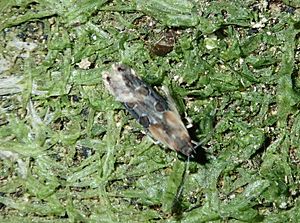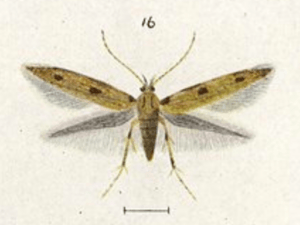Circoxena ditrocha facts for kids
Quick facts for kids Circoxena ditrocha |
|
|---|---|
 |
|
| Scientific classification | |
| Kingdom: | |
| Phylum: | |
| Class: | |
| Order: | |
| Family: |
Blastodacnidae
|
| Genus: |
Circoxena
|
| Species: |
C. ditrocha
|
| Binomial name | |
| Circoxena ditrocha Meyrick, 1916
|
|
Circoxena ditrocha is a tiny moth that belongs to the Blastodacnidae family. This special moth is found only in New Zealand. It's considered "At Risk, Naturally Uncommon" by the Department of Conservation. This means it's not often seen and needs some protection.
Contents
About This Moth
Who Discovered It?
The Circoxena ditrocha moth was first described in 1916. A scientist named Edward Meyrick gave it its name. He used a moth specimen collected by George Hudson. George Hudson found this moth in Wainuiomata in December.
Later, in 1928, George Hudson wrote about and drew pictures of this moth. He included it in his book called The butterflies and moths of New Zealand. The original moth specimen is kept safe at the Natural History Museum, London.
What Does It Look Like?
This moth is quite small, usually about 11 millimeters long. Its head is a shiny dark bronze color. The feelers (palpi and antennae) are white with black lines. The body is dark grey.
Its front wings are long and narrow. They are mostly a brownish-grey color with some darker streaks. There's a light yellow-orange patch near the base of the wing. You might also see two fine whitish rings on the wing.
Where Does It Live?
This moth is endemic to New Zealand. This means it is found naturally nowhere else in the world. It has been seen in many places across New Zealand. These places range from Auckland in the north to Invercargill in the south.
How Does It Behave?
Adult Circoxena ditrocha moths have been seen flying in December and March. George Hudson noticed that these moths are not very fast flyers. He could often collect them by gently sweeping through leaves and plants.
What Does It Eat?
Scientists are still trying to find out what the young moths (larvae) eat. They might be "seed borers," which means they could live inside and eat seeds. The adult moths seem to like living at the edges of forests or bushy areas. They are often found near a plant called Pseudopanax arboreus.
Is It Endangered?
Yes, this moth needs our help. It has been given the conservation status of "At Risk, Naturally Uncommon." This status is part of the New Zealand Threat Classification System. It means the moth is not very common in nature and could be at risk if its habitat changes.
Images for kids



